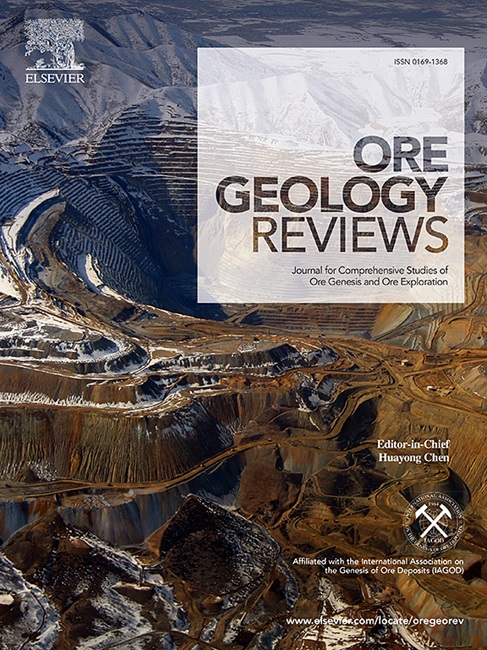华南马华坪Be-W-F矿床的形成:来自绿柱石化学、黑钨矿和独居石U-Pb定年的证据
IF 3.2
2区 地球科学
Q1 GEOLOGY
引用次数: 0
摘要
马华坪矿床赋存于变质沉积岩中,是三江地区规模较大的Be-W-F矿床,其矿物组合以绿绿石、白钨矿、黑钨矿、长三角石、萤石、方解石、石英等矿物为特征。然而,其成因模式仍然存在争议,特别是关于矿化是来自花岗岩衍生流体还是变质热液系统。利用激光烧蚀-电感耦合等离子体质谱法(LA-ICP-MS)对黑钨矿和独居石进行原位U-Pb定年,可以可靠地确定马华坪矿床的精确形成年龄。黑钨矿U-Pb年龄为30.6±0.5 Ma (2σ, MSWD = 0.74),与独居石U-Pb年龄29.4±0.3 Ma (2σ, MSWD = 0.63)基本一致。这些结果表明,麻花坪矿床形成于晚古近纪。结合三江地区斑岩型铜-金-钼矿床在时间上的相似性,以及多期矿物结构和绿绿石中FeO (0.09 ~ 1.68 wt%)和Na2O (0.59 ~ 2.05 wt%)含量的变异性,认为马华坪Be-W-F矿床是岩浆-热液流体形成的。在这种岩浆-热液模式下,我们认为三江地区具有重要的Be-W-F经济成矿潜力。此外,本研究还强调,除了有文献记载的Cu-Au-Mo成矿事件外,晚古近纪还发生了一次显著的Be-W-F成矿事件,从而扩大了三江地区的成矿格局,为今后的找矿提供了重要的参考。本文章由计算机程序翻译,如有差异,请以英文原文为准。

Formation of the Mahuaping Be–W–F deposit in South China: Evidence from beryl chemistry, wolframite and monazite U–Pb dating
The Mahuaping deposit, hosted within metasedimentary rocks, is a large-scale Be–W–F deposit in the Sanjiang region, distinguished by a unique mineral assemblage that includes beryl, scheelite, wolframite euclasite, fluorite, calcite, and quartz, among others. However, its genetic model remains a subject of debate, particularly regarding whether mineralization was sourced from granite-derived fluids or metamorphic hydrothermal systems. The precise formation age of the Mahuaping deposit can be reliably determined through in-situ U–Pb dating of wolframite and monazite using laser ablation-inductively coupled plasma-mass spectrometry (LA-ICP-MS). Wolframite U–Pb dating yield an age of 30.6 ± 0.5 Ma (2σ, MSWD = 0.74), closely aligning with the monazite U–Pb age of 29.4 ± 0.3 Ma (2σ, MSWD = 0.63). These results indicate that the Mahuaping deposit formed during the Late Paleogene. Given its temporal similarity to porphyry-related Cu–Au–Mo deposits associated with intracontinental transpression in the Sanjiang region, as well as multi-stage mineral textures and the variability in FeO (0.09–1.68 wt%) and Na2O (0.59–2.05 wt%) contents in beryl, we propose that the Mahuaping Be–W–F deposit was formed by magmatic-hydrothermal fluids. Under this magmatic-hydrothermal model, we suggest that the Sanjiang region holds significant potential for additional economic Be–W–F mineralization. Furthermore, this study highlights that, in addition to the well-documented Cu–Au–Mo mineralization event, the Late Paleogene also witnessed a notable Be–W–F mineralization episode, thereby expanding the metallogenic framework of the Sanjiang region and providing critical insights for future exploration.
求助全文
通过发布文献求助,成功后即可免费获取论文全文。
去求助
来源期刊

Ore Geology Reviews
地学-地质学
CiteScore
6.50
自引率
27.30%
发文量
546
审稿时长
22.9 weeks
期刊介绍:
Ore Geology Reviews aims to familiarize all earth scientists with recent advances in a number of interconnected disciplines related to the study of, and search for, ore deposits. The reviews range from brief to longer contributions, but the journal preferentially publishes manuscripts that fill the niche between the commonly shorter journal articles and the comprehensive book coverages, and thus has a special appeal to many authors and readers.
 求助内容:
求助内容: 应助结果提醒方式:
应助结果提醒方式:


